got a log of observations through my telescope. later i may add some phone images through it, and some reviews of the scope and eyepieces.
log:
natures nd filter - march 27th
- jupiter -
- am130eq, 12 starguider, 2x barlow omni, 9 kellner -
- cloudy, bad transparency, bad seeing -
uneventful. i knew it was cloudy but i saw intermittent clear patches so i set up outside. i tried to look at jupiter, first with the 12, then barlowed down 1.5, then with the 9 with 1.5x. the grs was facing us, but i couldnt even discern the texture of the cloud bands, let alone get a glimpse of the spot. it was a cool effect though when clouds came in front of jupiter, it acted like a moon filter, for a second it felt like i could see a bit more contrast in the reduced glare.
pleiades redemption and the great faint spot - march 24th
- sirius, pleiades, mars, jupiter -
- am130eq, 9 kellner, 25 x-cel lx, 12 starguider, 2x barlow omni -
- clear, good transparency, good seeing -
i tried to collimate the primary on sirius with the 9 and found again the inward and outward donuts disagreed. i just struck a compromise between the inward and outward donuts and left it at that, maybe i will redo the secondary another week or month.
i went to the pleiades with the 25, when i was unfocused outward some stars had really messed up donuts, but closer to the right focus draw length it was fine.
i switched to the 12, and dark adapted. this time i could see a glow around the stars without averted vision, the texture of light reminded me of the orion nebula, so i felt i was definitely seeing nebulosity on these stars. also when i slewed away from the pleiades the sky became a bit darker, and when coming back it became brighter again. i also saw the light delicate trail of stars southwest of the dipper of pleiades. i could tell most of them were just barely orange in color.
but seeing nebulosity on meroppe is still difficult. maybe theres the faintest thinnest light around it. i switched to the 9 to cut out more light pollution, and after a few moments i felt i was really seeing a paper thin glow stretching some few arc minutes around it. or its my imagination...
also while on pleiades i unintentionally caught in the view three satellites and even a plane. the plane was a jumpscare, looked like an ominous v shape of lights pass through, i thought it was a satellite constellation at first.
i went over to mars still with the 9, the image was very spiky. not diffraction spikes. the disc was still there, but there was a spiky halo or something around it, even though i felt i was focused. spikes almost as big as mars itself. i think this is the effect of the less perfect outer edge of the primary that i read about online. not an astromaster shortcoming, i think its common or just guaranteed with mirrors.
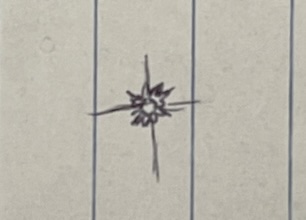
i went over to jupiter once i knew the grs was in view. with the 9 and 1.5 barlow, i noticed a weakening of the south band right where it contacts the left edge of the disc. after some ten or so minutes, i could see a hole in the dark band, and every now and then i felt i saw a faint dot just south of the band, directly under the hole. i switched to the 12 with the 1.5 and felt i could see the same detail almost, but the dot showed up less. jupiter was definitely bigger in the 9, and it felt a tad cleaner.
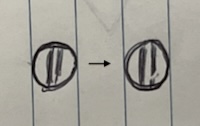
i noticed at some point the view was getting less crystal clear, in both eyepieces. i thought my eye was getting strained. but the halo was getting weird too. then i realised jupiter was setting behind a roof. so thats what gradual setting looks like through a telescope, less and less definiton.
the collimation to end all collimations - march 23rd
- sirius, jupiter -
- am130eq, 15 kellner, 2x barlow omni, 12 starguider, 9 kellner -
- clear, good transparency, okay seeing -
i read online that collimation donut images differing between inward and outward focus means the secondary mirror is out of alignment. makes sense to me, the donut would have a different appearance at every point through the focus range if the focuser axis and actual light path from the secondary were not aligned.
while sunlight was still out, i actually collimated the primary first before the secondary, because looking down directly through the tube i saw the reflected image of the secondary was way off center from the real secondary. i adjusted the screws at the back until the secondary and its reflection were roughly overlapped on each other.
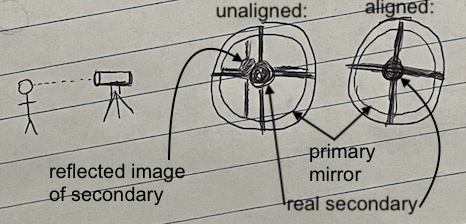
for an hour i adjusted the secondary. looking through a retracted focuser, the image of the primary would move unpredictably. tightening a screw would move it one way, then move it in the opposite way a minute later. two things were happening. one, if the collimation screws were a little loose, the secondary cell sags. two, unless everything was as tightened as can be, to the point of almost stripping screws, spinning a screw can spin the entire cell about its axis. it doesnt matter if a screw is getting tightened, or loosened, the whole cell would spin a small amount counter clockwise. frustrating.
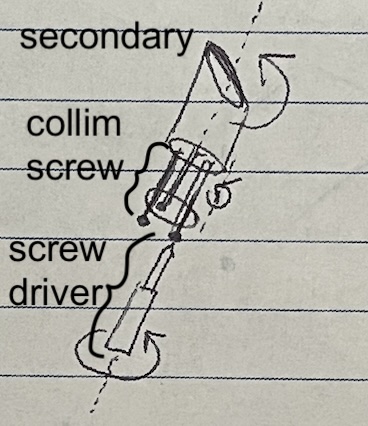
the process i repeated was:
-
slightly unscrew the main screw, the one connected to the cell
-
use another hand to hold the cell and spin it till the image of the primary is vertically well aligned
-
rotate the cell a small amount clockwise, to counteract any future spins counter clockwise
-
tighten back the main screw down hard
-
in small increments, adjust the collimation screws with equal amounts tightening and loosening (tighten one, loosen the other two, or vice versa)
-
maybe screw down the main screw again
-
repeat until happy with the image of the primary
and repeat i did, for an hour. i felt the secondary was okay, and moved to the primary. i collimated on sirius with the 15. for future reference, so i dont get it mixed up, tightening a primary collimation screw will push the shadow of the secondary back away from whatever side the screw is on. and for secondary collimation, only when everything is extremely tight, tightening a screw will push the image in the opposite direction the screw is located in.
i went to jupiter in the 15 and saw still again the donuts were different on inward and outward focus. but actually its just that the outward donut exaggerated the unevenness that was there on inward. i didnt re collimate, maybe another night.
i experimented with 'high' mag again on jupiter, now that seeing and transparency was better. the size looked all about the same through 15/2, 12/1.5, and 9/1.5 (really 10/1.5). details same too, i could discern the texture of the cloud bands equally. the 12 was obviously most comfortable. jupiter was slightly bigger in the 9, but maybe i would be happy after all with an 8 starguider. but the tmb clones also have a comfortable cup, and could offer closer mag to the 9/1.5.
odd donuts and magnification on jupiter - march 21st
- jupiter -
- am130eq, 7 x-cel lx, 9 kellner, 2x barlow omni, 12 starguider -
- clear, okay transparency, okay seeing -
i wanted to test the upper limit of magnifications with eyepieces. i focused on jupiter. on outward focus again the collimation felt off, and again inward focus looked better. in observing, i aimed to reach focus from inside. the 7 (6.5) was mushy and kind of dimmer than i expected. the 9 (10) with 1.5x was good but not as excellent as i remember from previous observations. there was the thinnest cloud layer over the sky, or haze, maybe thats the reason. but otherwise i could reach a clear sharp disc. sometimes the disc was sharper with a bit of unfocused halo. the 12 with 1.5x was the same performance as the 9. maybe its circumstantial, but with 12 i could see the shimmering of okay seeing. the 6.5 was not great, but its a toss up between the 12 and 9 barlowed down 1.5x. somehow jupiter in the 12 looked bigger than in the 9. maybe the afov difference affects this illusion. i need to test again in better seeing.
wheres the nebulosity pleiades? - march 20th
- sirius, pleiades, orion nebula, iota orionis -
- am130eq, 9 kellner, 25 x-cel lx, 12 starguider -
- clear, okay transparency, okay seeing -
maybe light pollution was a bit higher. i collimated on sirius with the 9. after collimating with focuser inside, when i focused outside the donut image was off again. i collimated outside and then inside was also fine, i dont know what happened. the uneven flair on sirius went away, so i didnt see pup after all that other night.
with the 25, i roughly aimed at the pleiades and followed a trail of light stars and came to the cluster. i could see again the middle stars three companions, one of which i couldnt see the other hazy night.
after ten minutes, i still couldnt see any nebulosity, so i switched to the 12. still after thirty minutes i couldnt see nebulosity directly. when i averted my vision, the bright stars had glows, which i thought could be nebulosity, but atlas and pleione had glow too, even if less glow, so im not sure. the light pollution may be washing out nebulosity.
i saw ads 2755 and could split them easily, they were wide apart. the north one had barely a warmer color, and the other was not as blue as the main stars.
pleiades set, then i switched to the orion nebula just to look at it before going inside. the nebula was bright and fuller thanks to dark adaptation. i went south to iota orionis and could barely see two stars, a brighter one and then a fainter star with a bit of distance in between. the second was very faint, i switched to the 9 kellner and i almost couldnt see it, because of fogging and the less light coming in.
after reading up on iota, it seems there is a third star, i guess i just saw the a and c stars.
averted vision in orion - march 18th
- orion nebula, jupiter -
- am130eq, 25 x-cel lx, 12 starguider, 2x barlow omni -
- clear, okay transparency, okay seeing -
i was late and missed the pleiades. i then went to the orion nebula. after dark adapting for a bit, in the 25 the light was good, but with averted vision it really popped. really glowed like a glowstick. it was the first time i deliberately used averted vision. with the 12 i saw an extra fainter star, and outlined the dark 'finger' and breadth of the nebula.
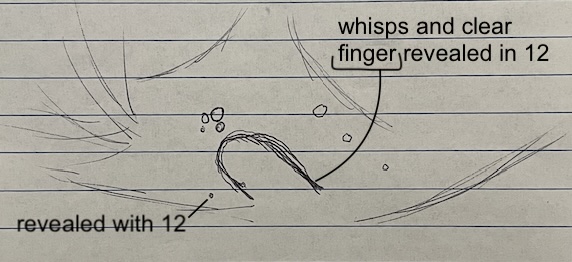
i went to jupiter still with the 12. i saw a moon really close to the disc. i added the 1.5 barlow and saw a second moon even closer.
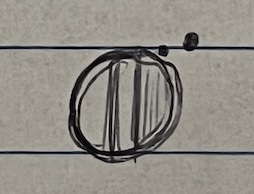
while focusing i realised there was uneven flaring and when focused far in or out i saw i was uncollimated a bit, maybe i didnt see the pup the other night, just the uneven flare.
on another note, the 12 barlowed down 1.5 made a good image of jupiter, compared to when i tested some time ago the 12 with 2x. so its not the case that the 12 has too many lenses and makes mushy images, its just that 108x is too much magnification and 81x is fine. to sum up past mag testing, 5 is too much, 9/10 with 1.5 is great (9 kellner is maybe 10 actually), 12 with 2 is mushy, unfocused halo, 6.5 is less mushy, and 12 with 1.5 is good. so the ideal max mag for this telescope is between 81 and 98, focal length between 6.6 and 8.
haze and gibbous mars - march 15th 2025
- orion nebula, pleiades, jupiter, sirius, mars -
- am130eq, 25 x-cel lx, 9 kellner, 2x barlow omni -
- clear, bad transparency, okay seeing -
it was supposed to be clear skies, even according to ecmwf. but there was haze or some thin cloud layer. i first tried the orion nebula but it was washed. that was in the 25, but i dont think the 12 wouldve helped. then i saw the pleiades, still washed out. but i mean, the stars were there, just less popped out, and the middle stars companions were fainter:
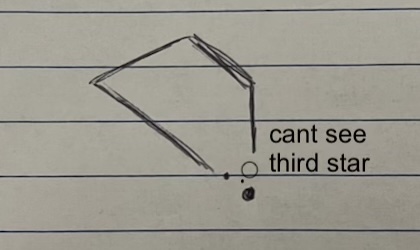
next i went to jupiter, still in the 25, looked nice and bright. then i saw it with with the 9 kellner and the 1.5 barlow. i had to spend more time at the eyepiece but i felt details were more clear when there was a bit of a halo:
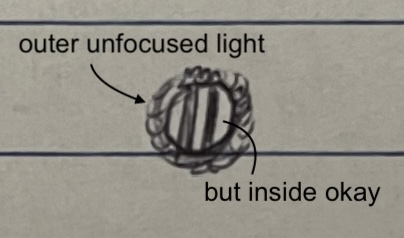
also the focuser is messed up, it clicks up and down, i shouldve never tried to mod the focuser, the slop before is preferable to what it is now. anyways next i did sirius, whos light was beautiful. maybe the pup was in the elongation or its an uneven flair...
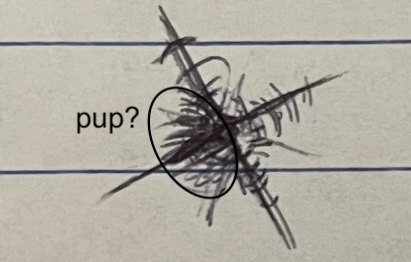
then i did mars. spent some time at it, focuser in and out. theres a couple things.
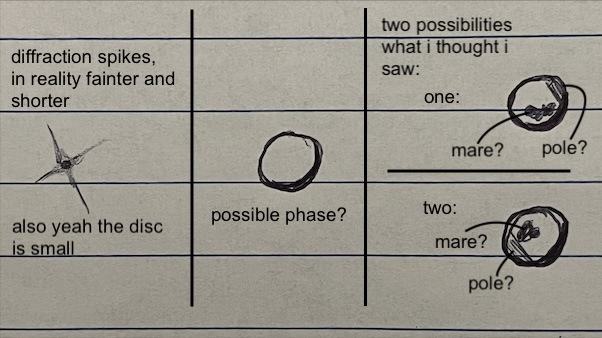
i feel like all the details are just my imaginations...
upon checking out stellarium, i was right about the phase at least.









